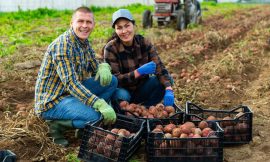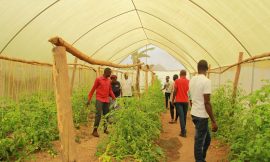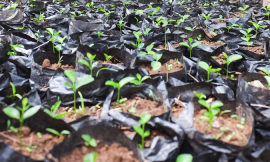Editor’s Note: As global food demand rises and climate risks intensify, agriculture must deliver more with less. Artificial Intelligence offers a powerful lever, but only if its tools reach beyond tech labs and large farms. This piece explores the AI trends reshaping farming worldwide and how ensuring that smart tools reach smallholder farmers through inclusive policies and robust support will be critical for truly sustainable and equitable food systems.
At the World Economic Forum in Davos, Syngenta Group CEO Jeff Rowe presented a compelling vision for how artificial intelligence (AI) will fundamentally transform agriculture in 2025. Speaking at a Bloomberg House panel titled “From Soil to Silicon: How Advanced Technologies are Cultivating the Future of Sustainable Ag,” Rowe declared that 2025 marks the pivotal year when AI transitions from promise to practice across global farming operations.
The transformation couldn’t come at a more critical time. With the global AI in agriculture market projected to nearly triple from $1.7 billion in 2023 to $4.7 billion by 2028, these technologies hold the potential to boost agricultural GDP in low- and middle-income countries by an astounding $450 billion annually, according to the World Economic Forum estimates.
The five AI trends reshaping agriculture
Syngenta’s analysis identifies five key areas where AI will drive agricultural transformation:
AI in R&D represents a fundamental shift in how agricultural innovations are discovered. Today at Syngenta, all research projects utilise machine learning models to identify novel active ingredients for both synthetic and biological products, dramatically accelerating the pace of innovation.
AI in the Field introduces sophisticated systems for monitoring and predicting soil health, enabling the creation of high-resolution maps detailing soil nutrients, texture and carbon content. These AI-driven insights allow farmers to make precise, data-informed decisions about their land management practices.
AI in Farmers’ Hands puts GenAI-enabled digital tools directly in farmers’ control, serving as intelligent agronomic advisors. These tools help determine optimal crop management practices tailored to specific field conditions and local contexts.
AI in Pest Management revolutionises crop protection through precision agriculture and data-driven decision-making. By targeting crop protection products only to infested areas, farmers can reduce chemical use while maintaining or improving yields.
AI in Supply Chain Management addresses post-harvest challenges through demand forecasting and market prediction, reducing overproduction and waste while optimising logistics and improving overall system efficiency.
Bridging innovation and adoption
These AI innovations represent powerful productivity-enhancing tools with immense potential to accelerate global agricultural productivity growth. However, their success depends critically on deployment strategies that address real-world implementation challenges. Without proper support systems, even the most sophisticated AI technologies risk becoming trapped in the “Valley of Death” – that critical gap between laboratory innovation and widespread farmer adoption.
The technologies Syngenta identifies exemplify innovations that require comprehensive bundling approaches to achieve meaningful impact. AI-driven agronomic advisors and precision pest management systems demand not just the technology itself but also robust digital infrastructure, farmer training programs, accessible financing options and supportive regulatory frameworks. Without these complementary elements, advanced AI tools may fail to reach the smallholder farmers who need them most.
“AI and digital tools are revolutionising farming and sustainable practices,” Rowe emphasised during the panel. “Advanced monitoring systems integrate satellite imagery, drones and soil maps to enable precise crop management. Predictive analytics, powered by AI and machine learning, provide farmers with actionable insights, transforming reactive practices into proactive strategies.”
AI as the path to productivity growth
The integration of AI across the entire agricultural value chain demonstrates how bundled approaches can create multiplier effects for productivity growth. When AI accelerates the development of better inputs in research labs, helps farmers optimise their use in the field, guides decision-making through digital advisors and reduces waste in supply chains, the combined impact far exceeds what any single technology could achieve in isolation.
During the panel discussion with Suzanne DiBianca, Executive Vice President and Chief Impact Officer at Salesforce, both speakers emphasised the critical need for collaboration among policymakers, businesses and stakeholders to reduce financial and technical barriers preventing farmer adoption of these technologies.
This collaborative approach is essential for ensuring that AI innovations translate into real productivity gains. The projected market growth and potential economic benefits underscore the transformative power of these technologies, but realising this potential requires addressing systemic barriers that prevent farmers from accessing and adopting new tools.
A resilient future through technology
The synergy between digital technologies and sustainable farming practices empowers farmers to tackle climate change while improving productivity. By integrating regenerative practices with cutting-edge AI technology, the agricultural sector is paving the way for a resilient food system that benefits both people and the planet.
As agriculture stands at this technological crossroads, the five AI trends identified by Syngenta offer a roadmap for transformation. Yet their ultimate success will depend not on the sophistication of the technology alone, but on creating comprehensive support systems that ensure these innovations reach every farmer who can benefit from them. Only through such integrated approaches can AI fulfil its promise of powering sustainable agricultural productivity growth at the scale and speed our world urgently needs.
This piece was initially published by the GAP Initiative at Virginia Tech and has been revised to suit Farming First editorial guidelines.






